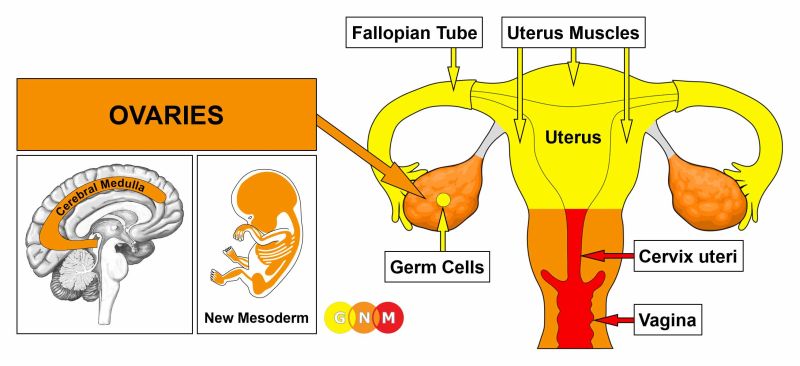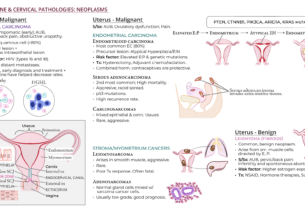In the depths of medical history lies a forgotten uterine mystery – the primordial uterus.
Unveiled by the brilliant mind of Johannes Peter Müller, the very existence of this enigmatic structure continues to fascinate scientists today.
Join us on a journey through the intricate world of the paramesonephric ducts, as we uncover their remarkable role in shaping the female reproductive system and unravel the complexities of persistent Mullerian duct syndrome.
Brace yourself for a captivating exploration into the realms of science and medicine…
primordial uterus
The primordial uterus refers to the initial development of the paramesonephric ducts in the female reproductive system.
These ducts are responsible for the development of the reproductive organs in females.
In males, the anti-Müllerian hormone (AMH) plays a crucial role in the regression of these ducts during development.
However, mutations in the AMH or AMH receptor genes can lead to the persistence of paramesonephric ducts in males, resulting in a condition known as persistent Müllerian duct syndrome.
This condition can manifest with varying degrees of abnormal reproductive structures, such as the presence of a uterus or fallopian tubes in males.
Paramesonephric duct anomalies can also lead to complications and difficulties in diagnosis.
However, surgical advances have improved sexual function, fertility, and obstetric outcomes for women with these anomalies.
Additionally, assisted reproductive technology has provided options for women with paramesonephric duct anomalies to conceive and have children.
Overall, the primordial uterus and paramesonephric duct anomalies are important factors to consider in understanding reproductive development and associated medical conditions.
Key Points:
- The primordial uterus is the initial development of the paramesonephric ducts in the female reproductive system.
- These ducts are responsible for developing reproductive organs in females.
- In males, the anti-Müllerian hormone (AMH) causes regression of these ducts during development.
- Mutations in the AMH or AMH receptor genes can lead to persistent paramesonephric ducts in males, resulting in persistent Müllerian duct syndrome.
- This condition can lead to abnormal reproductive structures in males, such as a uterus or fallopian tubes.
- Paramesonephric duct anomalies can cause complications and difficulties in diagnosis, but surgical advances and assisted reproductive technology have improved outcomes for affected individuals.
primordial uterus – Watch Video
💡
Pro Tips:
1. The primordial uterus, also known as the müllerian duct, is present in males during early embryonic development but regresses to form other structures in the reproductive system.
2. Some species of reptiles, such as turtles and crocodilians, possess a pair of primitive uteruses in females, called duplex uteri, which can produce multiple clutches of eggs with different fathers.
3. The concept of the primordial uterus was first proposed by German anatomist Johannes Müller in 1830, who uncovered its developmental significance through his studies of embryology.
4. Interestingly, the presence of the primordial uterus in male embryos is a remnant from our evolutionary ancestors and is similar to the female reproductive system found in fish.
5. In some mammals, such as kangaroos and koalas, the primordial uterus plays a unique role in reproducing efficiently. These animals have a bifurcated uterus, allowing them to simultaneously carry developing offspring at different stages of development.
1. Primordial Uterus: Development Of Paramesonephric Ducts In The Female Reproductive System
The development of the female reproductive system begins with the formation of the primordial uterus. This intricate process relies on the proper development of the paramesonephric ducts. These ducts, also known as Müllerian ducts, are responsible for the formation of the fallopian tubes, uterus, cervix, and upper portion of the vagina.
During embryonic development, the paramesonephric ducts arise from the coelomic epithelium. As the embryo grows, these ducts elongate and migrate towards the urogenital ridge. Along the way, they form a series of small buds that will eventually develop into the various components of the female reproductive system.
The development of the paramesonephric ducts is tightly regulated by a complex network of gene expression and signaling pathways. These pathways orchestrate the growth, differentiation, and morphological changes necessary for the formation of the female reproductive organs. Any disruptions in this delicate process can lead to various congenital abnormalities and fertility issues in women.
2. Role Of Anti-Müllerian Hormone (Amh) In Regression Of Paramesonephric Ducts In Males
In males, the paramesonephric ducts naturally regress due to the presence of Anti-Müllerian Hormone (AMH). This hormone, secreted by the developing testes, plays a crucial role in the sexual differentiation of the reproductive system.
AMH binds to its receptor on the paramesonephric ducts, triggering a signaling cascade that leads to their regression. As the ducts regress, the embryo’s male reproductive organs, such as the epididymis, vas deferens, and seminal vesicles, can develop unimpeded.
This process highlights the significance of AMH in male reproductive development, ensuring the differentiation and proper formation of the male reproductive tract while inhibiting the formation of female reproductive structures.
- AMH is secreted by the developing testes
- It binds to its receptor on the paramesonephric ducts
- Triggering a signaling cascade that leads to duct regression
- Allows male reproductive organs to develop unimpeded
“The presence of AMH is crucial for the proper formation of the male reproductive tract.”
3. Persistence Of Paramesonephric Ducts In Males With Amh Or Amh Receptor Gene Mutations
Mutations or abnormalities in the AMH or AMH receptor genes can lead to the persistence of the paramesonephric ducts in males. This condition, known as Persistent Müllerian Duct Syndrome (PMDS), results in the formation of both male and female reproductive organs.
Individuals with PMDS often present with undescended testes, abnormal male external genitalia, and the presence of a uterus and fallopian tubes. These unique anatomical features can cause complications, such as hernias, infertility, and an increased risk of testicular tumors.
The persistence of paramesonephric ducts in males with AMH or AMH receptor gene mutations underscores the critical role of AMH in preventing the development of female reproductive structures in males during embryonic development.
Stay tuned for the next section of this article, where we will explore Persistent Müllerian Duct Syndrome and its manifestations.
- Mutations or abnormalities in the AMH or AMH receptor genes lead to the persistence of the paramesonephric ducts in males.
- This condition is known as Persistent Müllerian Duct Syndrome (PMDS) and results in the formation of both male and female reproductive organs.
- Individuals with PMDS often present with undescended testes, abnormal male external genitalia, and the presence of a uterus and fallopian tubes.
- Complications of PMDS can include hernias, infertility, and an increased risk of testicular tumors.
- The persistence of paramesonephric ducts in males with AMH or AMH receptor gene mutations highlights the critical role of AMH in preventing the development of female reproductive structures in males during embryonic development.
Stay tuned for the next section of this article, where we will explore Persistent Müllerian Duct Syndrome and its manifestations.
💡
You may need to know these questions about primordial uterus
What is primordial uterus?
The primordial uterus refers to the early development stage of the uterus in which it is initially lined by a single layer of cuboidal epithelium. As development progresses, this epithelium undergoes transformation, becoming columnar and pseudostratified. Below the epithelium, a condensed mesenchyme forms, giving rise to the endometrial stroma and the surrounding myometrium. This early stage is crucial for the subsequent development and functioning of the uterus.
What are the different types of uteruses?
The different types of uteruses include the bicornuate uterus, which is characterized by a heart-shaped structure, and the arcuate uterus, which exhibits a similar shape but with a less pronounced dip or heart shape. Another type is the septate uterus, where the uterus is partitioned into two parts by a membrane. Lastly, there is the unicornuate uterus, which is irregularly shaped and typically has only one fallopian tube. These various types of uteruses highlight the diverse anatomical variations that can exist within the female reproductive system.
What is the embryological origin of the uterus?
The uterus, a vital component of the female reproductive system, originates from the mesoderm during embryonic development. As Mullerian organogenesis takes place, the uterus forms along with the upper part of the vagina, the cervix, and the fallopian tubes. This complex process involves the transformation and differentiation of cells derived from the mesoderm, contributing to the formation of these crucial reproductive structures.
What is the rarest uterus?
The rarest uterus could be the didelphic uterus, also known as a double uterus. This uncommon condition occurs when a person is born with two separate uterine cavities and two cervixes. Each cavity can have its own fallopian tube, leading to a unique reproductive system. The double uterus is a congenital abnormality that arises during fetal development, resulting in a distinct and intriguing uterine structure unlike the typical single uterus.
Reference source
https://www.sciencedirect.com/topics/medicine-and-dentistry/female-reproductive-tract
https://www.ncbi.nlm.nih.gov/books/NBK470297/
https://my.clevelandclinic.org/health/body/22467-uterus
https://www.ncbi.nlm.nih.gov/books/NBK547748/



